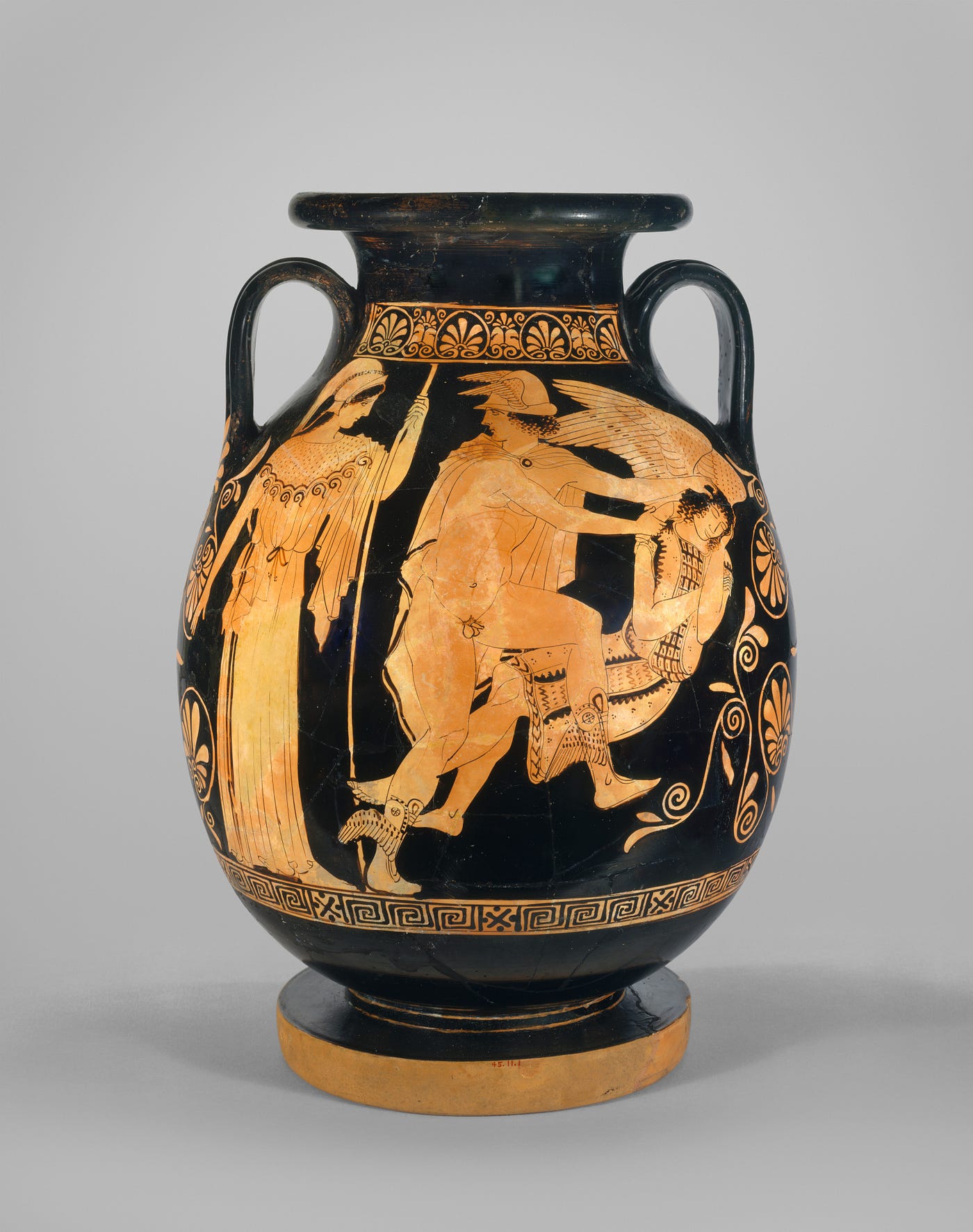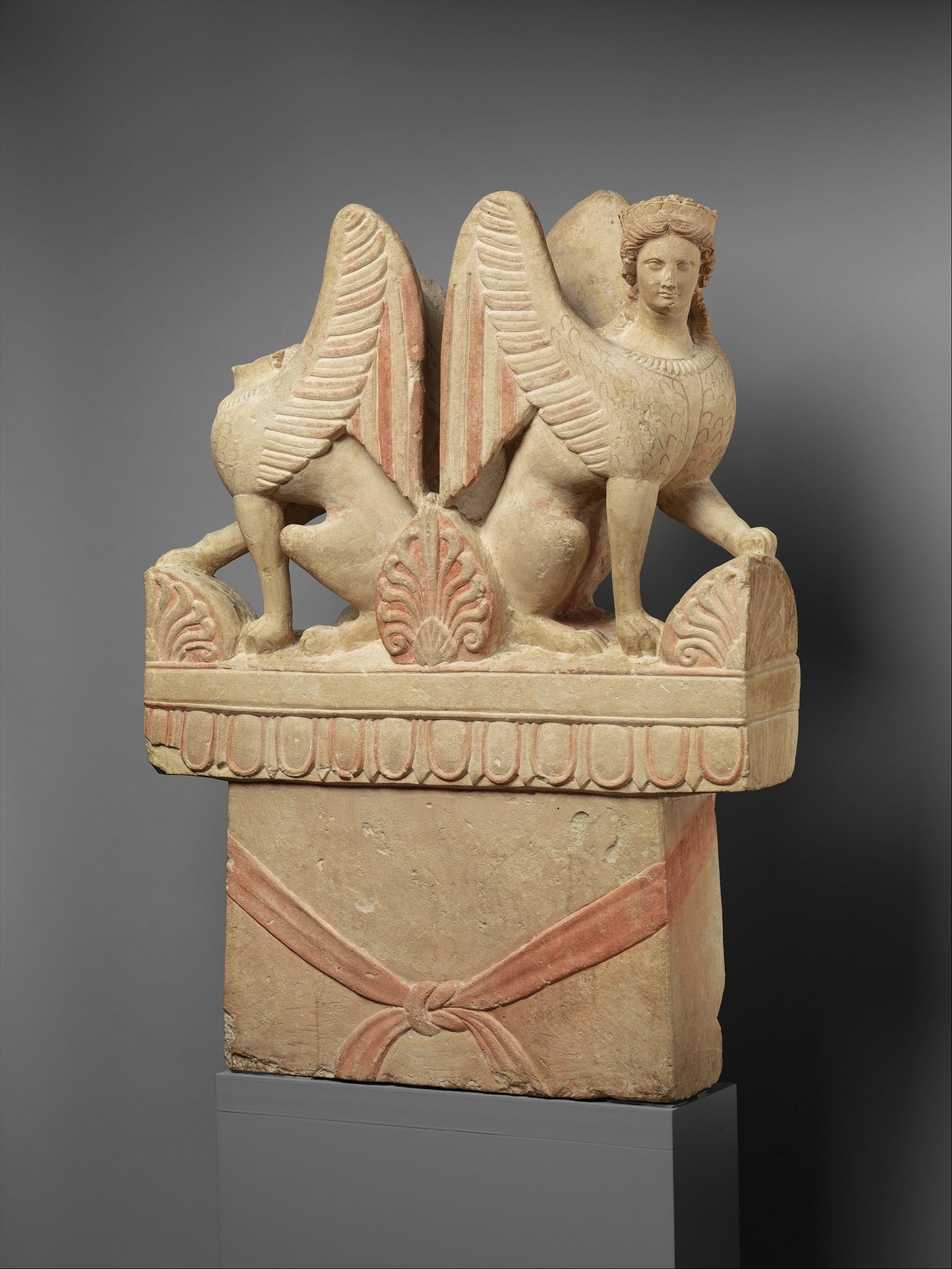What Did You Learn From the Dangerous Beauty Medusa in Classical Art Exhibit
Medusa at the Metropolitan
A Review of "Unsafe Beauty: Medusa in Classical Fine art"

The advent of the vacation season in New York City brings fantastical decorations, sumptuous shop windows, and succulent sweetness treats. But, it is a time of year that also draws crowds on the subway, hordes in the grocery store, and multitudes in museums. Visiting the Metropolitan Museum of Fine art on a Saturday afternoon I was delighted past the volume of people enjoying the artworks, but rather annoyed I could non inspect closely the fabulous marble head of Alexander on loan from the Pergamon Museum in Berlin, or that my view of a Delacroix painting was marred by a dozen cell phones. However, if y'all make information technology through the ever-busy Great Hall, wind your fashion through the Classical Sculpture gallery, and climb the stairs next to that stately cavalcade from Sardis, you may manage to escape the crowds. Tucked away on this balcony above the Roman atrium is a small gallery devoted to a little jewel of an exhibition, Unsafe Beauty: Medusa in Classical Fine art.
The testify comprises well-nigh sixty objects drawn more often than not from the Metropolitan's own collection and explores the artistic evolution of Medusa, the snake haired Gorgon cursed past Athena and slain by Perseus, from terrifying monster to attracting woman. The showroom'south creator, Kiki Karoglou, Associate Curator in the Department of Greek and Roman Fine art, weaves together the myths of unlike female monsters and draws on more contemporary artworks to create a compelling narrative on the transformation of Medusa and the questions that the Gorgon's story provokes
Upon entering the gallery one is greeted past the tones of a soundscape by Austin Fisher (available on the exhibitions website), equanimous in response to the objects surrounding the company. The music is in turns a gentle hum accented with melodic chimes and so a brash horn; the juxtaposition reflects the contrast presented by the artifacts on brandish and in the figure of Medusa. This tension between the different Medusa types, unsafe and dazzling, was beautifully illustrated in the showtime cased I examined. On the top shelf sat two different bronze greaves (shin guards), dating from sixth and fourth century BC Hellenic republic respectively. The earliest portrayed a Gorgon with long, sharp fangs bracketing her extended natural language and atop her head snakes stood tall and menacing with more than reptiles circling her face in a mass. The afterward bronze Medusa was serene with sad, broad set eyes and face up fame by a single pair of snakes neatly tied in a bow below her chin. In both periods Medusa is used to adorn armor and serve a protective or apotropaic function for those in gainsay, but over two centuries tastes inverse and the two representations are very unlike.
The exhibition as well includes one of the primeval examples of a Medusa in the form of a beautiful maiden, versus terrifying monster. In a red-effigy pelike from the mid-5th century, pre-dating the greave with the placid Gorgon past a century, she is depicted fast asleep with Perseus poised to behead the oblivious woman. There are no snakes or fangs to label Medusa as a monster. The scene is identifiable, not because of Medusa's appearance, but considering Perseus looks away from his victim, afraid of being turned to stone. To me, the depiction is sympathetic to Medusa, as Perseus looks almost comical and decidedly unheroic attacking a woman who is soundly sleeping.

As Medusa transformed from grisly to girlish during the Archaic to Hellenistic periods, so did other mythical female creatures. The exhibition explores the change in representations of Scylla and the Sirens, famed for their part in delaying Odysseus'southward return to Ithaca in Homer's epic. The show also brings together several depictions of sphinxes, creatures with the body of lion, wings of an hawkeye, and caput of a woman. More gimmicky depictions of these creatures are displayed aslope ancient examples. A comely sphinx, part of an early on 4th century grave stele, is bundled facing and appears to contemplate, a 20th century woodcut of a seductive siren with wild pilus past Raoul Dufy. One wonders what the sphinx thinks of Dufy'due south siren.

The exhibition is sprinkled with objects that significantly mail-appointment the aboriginal Greeks. The objects allude to the concept of the enticing, but sinister female that arose in reaction to afterwards gains in women'southward independence and empowerment. One of the nearly striking mod pieces in the room, prominently displayed next to the dramatic golden letters set against a dark grey wall that announce the title of the showroom, is a black Versace cocktail dress from the designer's iconic Autumn/Winter 1992–93 "Miss S&One thousand" collection. If one examines the clothes closely you will see the buttons do non show the traditional Versace Medusa, but one with her mouth opened wide in a scream and her confront twisted in anguish. What practise these buttons say almost Medusa, about women, about the position of women in ancient and modern societies, and how the status of women has changed legally and artistically? To me, the more modern objects provoked questions on gender and sexuality in the myth of Medusa, merely did non face up some of the more than difficult elements. This gap is an opportunity for a chat.
This trivial gem box of an exhibition is a drove that sparks word, on Greek art, on the manual of aboriginal texts, and on the perceptions and role of women in the ancient and modern earth and how those stereotypes have changed, or non. The questions the exhibition raises are best set against a trivial context and then I recommend browsing the Museum Message (available online with GoogleBooks) for Dr. Karoglou'south total assay of the transition in Greek fine art and the subsequent repurposing of Medusa by artists of different generations. For ancient sources a visitor might want to skim in chronological guild to compare the literary and artistic development of Medusa, these relevant texts: Hesiod (Theogony 270–82), Apollodorus (Library 2.4.i–two), Ovid (Metamorphosis 4.604–5.249). The great reward of this exhibition is the power to intimately examine and compare dissimilar objects; I institute a little preparation allowed me to spend my time in the galleries focused on the objects instead of the wall text.
And for those who cannot brand time to visit Dangerous Beauty during a busy holiday season, combining the existing online resources (the Bulletin, the Met'south website, and browsing the ancient texts) provides a wonderful opportunity to gain familiarity with dissimilar variations of the Medusa myth. I have assigned potential visitors a lot of homework for a fun, holiday trip to the museum, and while grooming augments the experience, the objects on display are aesthetically beautiful and illustrate conspicuously Medusa'south transition from "dangerous" to "beautiful" in ancient Greek fine art. The little gallery is a wonderful place to spend a few restful minutes contemplating the artworks and the relevance of Medusa myth today.
Unsafe Beauty: Medusa in Classical Art is on view through January vi, 2019 at the Metropolitan Museum of Art in New York City.
Henrietta Hakes is a Development Officer at the Paideia Institute.
Source: https://medium.com/in-medias-res/review-dangerous-beauty-medusa-in-classical-art-859ef4f153d0
0 Response to "What Did You Learn From the Dangerous Beauty Medusa in Classical Art Exhibit"
Enregistrer un commentaire